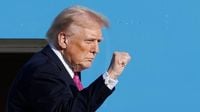Oil markets, diplomats, and world leaders are all grappling with the latest twist in the ongoing geopolitical drama surrounding Russian oil—and, as ever, U.S. President Donald Trump is at the center of the storm. In a week marked by high-stakes meetings, bold claims, and a flurry of diplomatic maneuvering, Trump has repeatedly asserted that India is on the verge of halting its purchases of Russian crude oil. The move, he says, would be a significant step in the U.S.-led campaign to squeeze Moscow’s energy revenues and force an end to the war in Ukraine.
But is this seismic shift really about to happen? Or is it, as some in the markets and diplomatic circles suspect, more political theater than imminent policy?
According to Reuters and Yahoo Finance, Trump declared at the White House on October 17, 2025, “They’ve already de-escalated.” He went further, claiming that Prime Minister Narendra Modi had personally assured him India would stop buying oil from Russia. “That’s a big step. Now we’re going to get China to do the same thing,” Trump told reporters, signaling that his administration’s pressure campaign was just getting started.
Yet, Indian officials have been quick to pour cold water on these assertions. Throughout the week, representatives in New Delhi and at the Indian embassy in Washington stated they were unaware of any such conversation between Modi and Trump. As of mid-October, no official confirmation of a commitment to halt Russian oil purchases had emerged from the Indian side.
The confusion comes at a particularly sensitive moment for India’s foreign policy. The country is caught between its need for affordable energy—Russia has become its top oil supplier, accounting for roughly a third of India’s oil imports, or 1.62 million barrels per day in September 2025—and the allure of a lucrative trade deal with the United States. Trump’s administration has ramped up the pressure, slapping India with a 25% blanket tariff on exports to the U.S., plus an additional 25% specifically in response to its Russian oil purchases. Analysts cited by India Today and Yahoo Finance warn that these tariffs have already led to a sharp 37.5% drop in Indian exports to the U.S. since their imposition.
“India needs the trade deal with the U.S. India also needs reasonably priced energy. There is no binary choice here. India needs both,” one expert told India Today, encapsulating the strategic dilemma facing New Delhi. The stakes are high, and the choices are anything but simple. With U.S. tariffs biting and oil prices fluctuating, Indian officials are seeking to diversify their energy sources “as appropriate,” while also promising to increase imports from the United States. But as trade data and diplomatic statements show, the country is not yet ready to turn its back on discounted Russian crude.
The week’s headlines were dominated by a flurry of diplomatic activity. Indian officials were in Washington for annual meetings of the International Monetary Fund and World Bank, reportedly discussing trade and tariffs with the Trump administration. Meanwhile, Trump made clear that his ambitions extended beyond India. He announced plans to discuss the issue with Chinese President Xi Jinping at an upcoming summit in South Korea at the end of October. Trump said he was hopeful the war in Ukraine could be ended before this meeting, adding, “I’ll be discussing that” with Xi—an indication that energy, trade, and geopolitics remain tightly interwoven in his foreign policy approach.
Trump’s strategy, as outlined in Reuters and Yahoo Finance, appears to be leveraging bilateral relationships and economic might to isolate Russia, rather than relying solely on broad multilateral sanctions. The U.S. Treasury Secretary, Scott Bessent, even told Japanese Finance Minister Katsunobu Kato that Washington expected Japan to stop importing Russian energy as well. So far, however, only India has faced direct tariffs for its Russian oil purchases; other major buyers, like China and Turkey, have not been similarly targeted.
Market reaction to the week’s drama was muted, with Brent crude oil prices seeing only slight declines. As Oxford Economics noted, “President Trump said India will end Russian oil purchases, although the relatively muted market reaction suggests some skepticism.” The skepticism is not unfounded. According to Reuters, some Indian refiners are preparing to trim their Russian oil imports, but a full halt appears unlikely in the immediate future. Trump himself acknowledged that India could not “immediately” stop shipments, calling it “a little bit of a process, but that process will be over soon.”
For Russia, even a partial reduction in Indian purchases could be a significant blow. The Russian economy remains deeply dependent on energy revenues, and India and China are now its two largest buyers of seaborne crude, taking advantage of discounts created when Western nations shunned Russian oil after the Ukraine invasion in 2022. Any significant shift by India would not only impact Moscow’s bottom line but could also reshape global oil flows and the calculus for other countries still importing Russian crude.
This high-stakes game played out against the backdrop of a major White House visit by Ukrainian President Volodymyr Zelensky. On October 17, Zelensky met with Trump, discussing both energy and military support. “A good opportunity to meet with big American energy companies, and they’re ready to help us,” Zelensky said, highlighting the importance of energy in Ukraine’s recovery. The atmosphere was notably cordial—quite a change from a previous, more contentious Oval Office meeting earlier in the year.
Looking ahead, Trump is scheduled to meet with Russian President Vladimir Putin in Hungary in a few weeks, with the possibility that Zelensky could also attend. Trump was candid about the prospects for a direct meeting between the Ukrainian and Russian leaders, remarking, “There’s a lot of bad blood.” The diplomatic chessboard remains complex and unpredictable.
For India, the coming weeks will be critical. The government faces mounting pressure from Washington to align more closely with U.S. policy on Russia, while also contending with domestic imperatives for affordable energy and the economic fallout of U.S. tariffs. As Alexander Slater and Ashok Malik, two analysts cited in India Today, pointed out, India’s best hope may be to continue walking a tightrope—seeking incremental reductions in Russian oil imports, negotiating for tariff relief, and diversifying its energy sources without abruptly severing ties with Moscow.
As the world watches, oil markets may remain skeptical, but the diplomatic stakes could not be higher. The outcome will not only shape the future of India-U.S. relations but could also have far-reaching consequences for the global energy landscape and the ongoing war in Ukraine.
The next moves—at summits in South Korea and Hungary, in the halls of Washington, and in the refineries of India—will be watched closely by all sides. For now, uncertainty reigns, but one thing is clear: the intersection of oil, trade, and geopolitics has rarely been so fraught, or so consequential.


